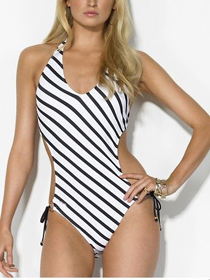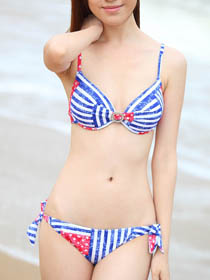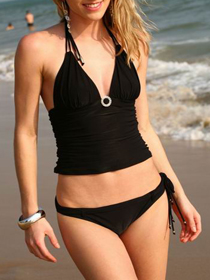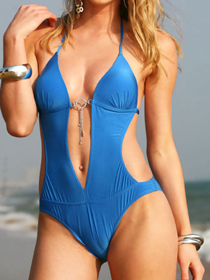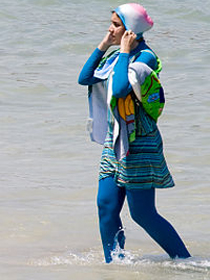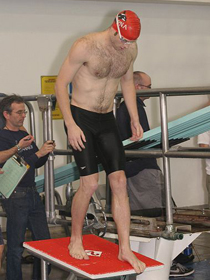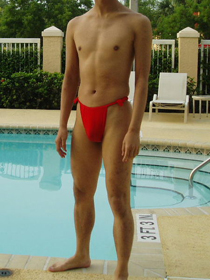
A swimsuit can be worn as an undergarment in sports that require a wetsuit such as water skiing, scuba diving, surfing, and wakeboarding. Swimsuits are also worn when there is a need to display the body, as in the case of beauty pageants or bodybuilding contests.
Swimsuit styles
| There is a very wide range of styles of modern swimsuits, which vary in relation to body coverage and materials. The choice of style of swimsuit is dependent on current fashions and community standards of modesty, as well as on personal preferences. In western culture, men's swimsuit styles include boardshorts, jammers, swim trunks, briefs or "speedos", thongs, and g-strings, in order of decreasing lower body coverage. Women's swimsuits are generally described as one-piece, bikinis, or thongs. While they go through many trends in pattern, length and cut there is not much modification to the original variety of suit. A recent innovation is the burqini, favored by Muslim women, which covers the whole body and head (but not face) in a manner similar to a diver's wetsuit. | |
Unisex styles
| Name | Description |
| Rash guard (also known as rash vest or rashie) | A type of athletic shirt made of spandex and nylon or polyester. Rash guards may be worn as an alternative to wetsuits during warmer weather. They may also offer UV protection. |
| Wetsuit and Dry suit | A close fitting, insulating garment usually made from neoprene or similar material. |
| Drag suits | A pair of shorts or any loose shirts worn over a swimmer's inner swimsuit to increase resistance against the water and build up the swimmer's endurance. |
| Racing suits | Swimsuits made of technologically advanced fabrics biomimetically designed with a surface that mimics the rough shark denticles to reduce drag along key areas of the body. The characteristics of the fabric improve shape retention and increase muscle compression to reduce vibration and retain muscle shape to reduce fatigue and power loss. Available in a variety of cuts such as bodyskin, legskin and kneeskin. |
Women's Swimsuits
| | | |
| | |
|
Note:
1. One-piece is also known as tank suit, maillot. Probably the most common form of one-piece swimsuit, the tank suit form is inspiration for the subsequent creation of the tank top as a mainstream article of clothing. The name "tank suit" is also supposed to be derived from the term "swimming tank", an obsolete term for what is now called a swimming pool.
2. Bikini is also known as two piece. One piece covers the breasts, the other the groin and buttocks, leaving an uncovered area between the two. Bikinis are available in many stylistic variations.
3. Tankini is also known as two piece. Two piece covers the breasts and stomach (like a tank top), the other the groin and buttocks. Leaves a small gap in between the belly button and the hips. Tankinis are available in many stylistic variations.
4. Monokini Refers to:
- A women's swimsuit with one piece that exposes the breasts, originally invented by Rudi Gernreich in 1964, available in many stylistic variations and generally refers to a bikini bottom, or thong worn alone without a top.
- A recent trend in women's one-piece swimsuits. It is typically styled so that from the front it looks like a typical one-piece with side cut-outs, but from the back it looks like a bikini. Many monokini styles also include plunging necklines
5. Burqini covers the whole body and head (but not face) in a manner similar to a diver's wetsuit.
Men's Swimsuits
| | | |
| | |
|
Note:
1. Swim briefs was launched at the 1956 Melbourne Olympics by Speedo, originally nylon swimwear in the same style as underwear briefs. Swim briefs are now often made of a nylon and spandex composite, while some longer lasting suits are made from polyester. The style varies from a full seat to thong or g-string. Most swim briefs have a beige or white lining on the inside front made of a similar fabric.
2. In the US, this describes a loose, mid-thigh style of swimwear, made of 100% polyester or 100% nylon fabric. They are usually shorter than boardshorts but longer than boxer shorts. They feature a polyester liner inside the shorts. Although trunks have been used as swimwear since the 1940s, their heyday was in 1990s when they were highly popularised thanks in part to TV shows like Baywatch. Today, they have been eclipsed by boardshorts among teenagers and young adults. They remain the norm with older age groups and young children.
In other cultures (particularly the UK) the term 'trunks' is used to describe swim briefs, although it has been increasingly common for any men's swimwear to be generically described as 'trunks'.
3. Square leg suits refers to a swimwear style similar to swim briefs, but with a much more conservative cut. They can be compared to boxer briefs but with nylon/spandex composite or polyester fabric.
4. Jammer is a type of men's swimwear worn primarily by competitive athletes, somewhat resembling cycling shorts or compression shorts.
5. Fundoshi is a traditional Japanese style of underwear, sometimes worn as swimwear.
Swimwear and hygiene
Germs, bacteria, and mold can grow very quickly on wet bathing suits. Medical professionals warn that wearing damp swimwear for long periods of time can cause a number of infections and rashes in children and adults, and warn against sharing bathing suits with others. They suggest changing out of a wet bathing suit right away can help prevent vaginal infections and itching in females and Tinea Cruris "Jock Itch" in males.
Reference: wikipedia
Written by Nicolas Yang

